November 2024
The global simulation software market size accounted for USD 23.89 billion in 2024, grew to USD 27.19 billion in 2025 and is projected to surpass around USD 87.18 billion by 2034, representing a healthy CAGR of 13.82% between 2024 and 2034. The North America simulation software market size is calculated at USD 8.36 billion in 2024 and is expected to grow at a fastest CAGR of 30.95% during the forecast year.
The global simulation software market size is estimated at USD 23.89 billion in 2024 and is anticipated to reach around USD 87.18 billion by 2034, expanding at a CAGR of 13.82% between 2024 and 2034.
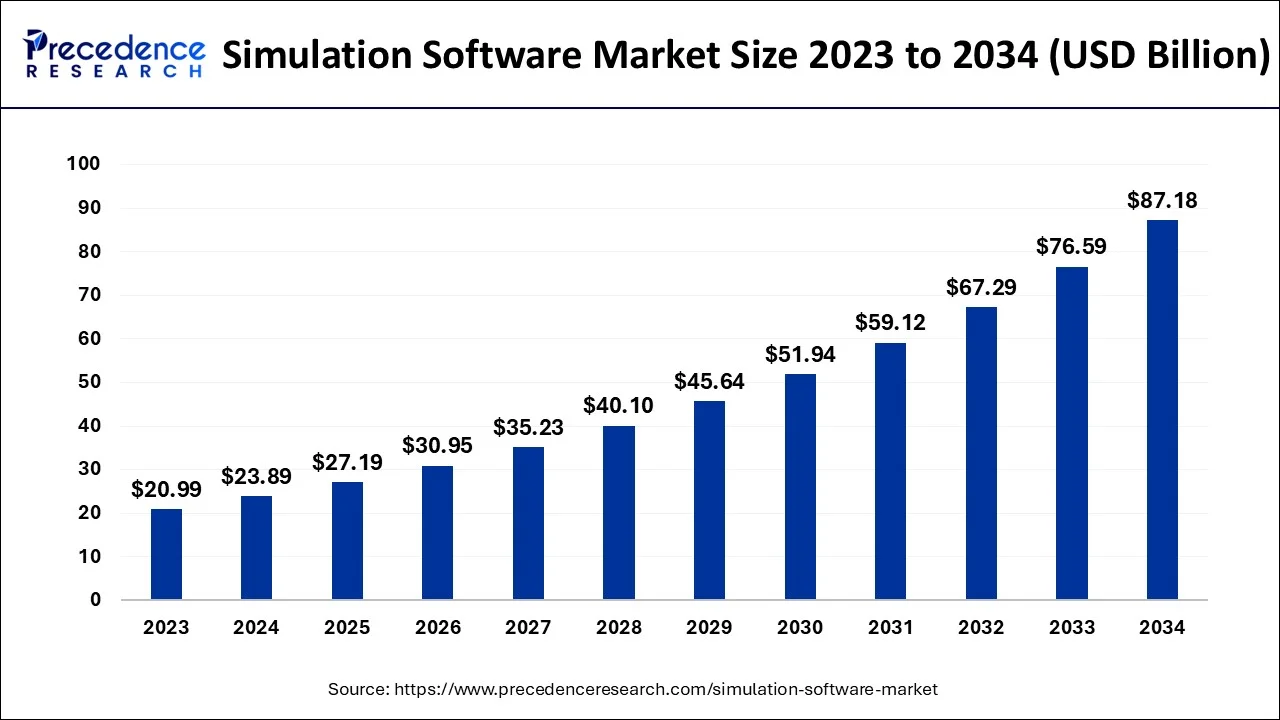
The U.S. simulation software market size accounted for USD 5.85 billion in 2024 and is expected to be worth around USD 21.82 billion by 2034, expanding at a CAGR of 14.05% between 2024 and 2034.
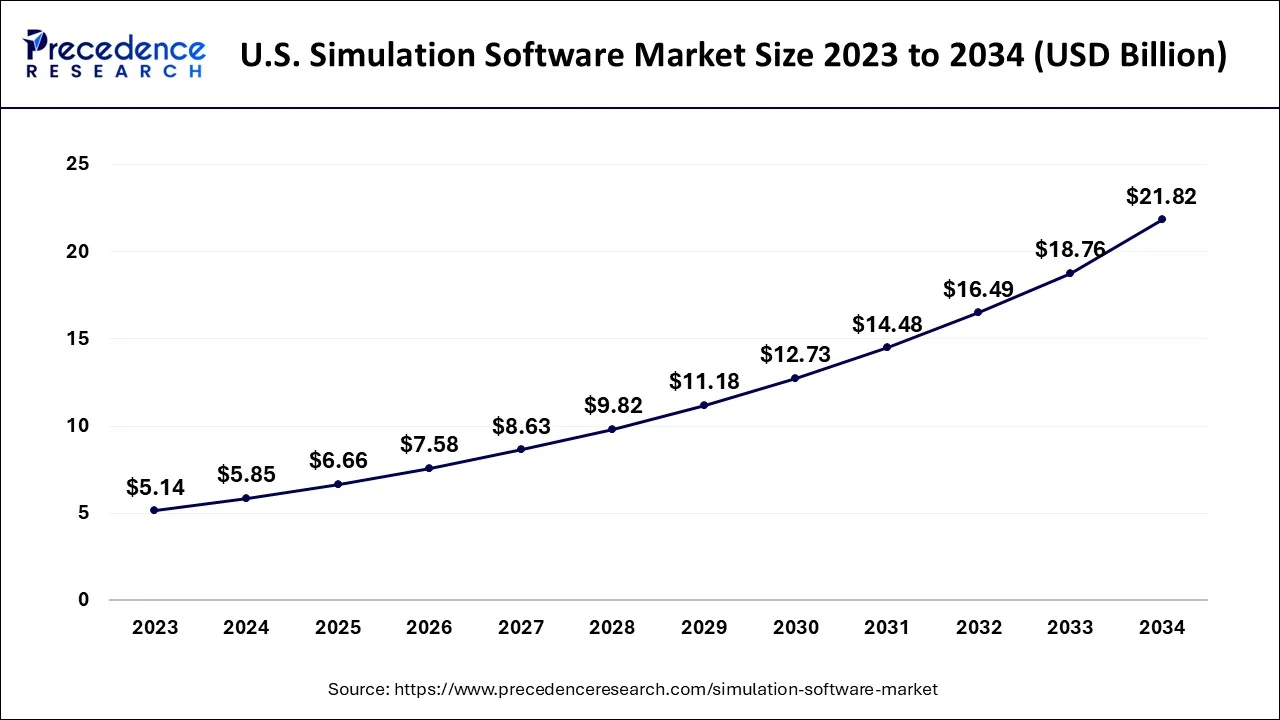
North America led the market in 2023 and contributed 35% of total revenue. Due to the presence of significant players from the United States and Canada, the area is anticipated to maintain its dominance during the projected period. It has been noted that businesses in these nations spend in R&D initiatives to release technologically superior items on the market. Additionally, the area is renowned for being an early user of cutting-edge technologies.
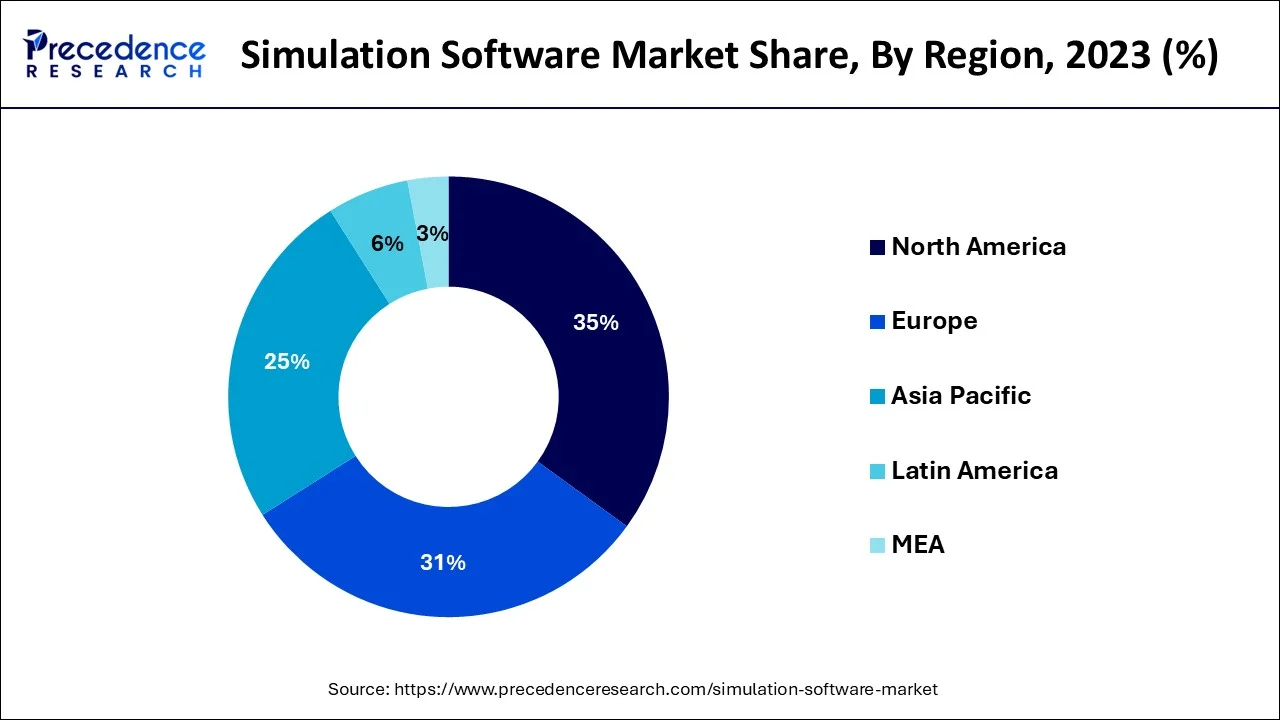
Asia Pacific is expected to grow at the fastest pace in the simulation software market during the forecast period. The overall expansion of gaming and designing industries with the robust interation of artificial intelligence and associated advanced technologies in the similar industries are observed to promote the market's expansion. Countries such as Japan, China, India and South India are seen to expand at a robust pace with several R&D initiatives and overall government investments in AI training. Moreover, the rising efforts in manufacturing process optimization in well-established countries including Japan and China are seen to supplement the market's growth. Additionally, as the logistics management in the Asian part grows, the requirement for cloud-based simulation software is seen to expand.
A simulation is a computer-based model that relies on physics and mathematics concepts. It makes it possible to create, test, and improve goods and solutions. It may also be seen as a tool with several uses, including gamification, product engineering, and research and development (R&D). Because it provides design verification and validation for R&D activities, businesses are drawn to simulation and analysis technologies. Simulated environments are helpful for learning and training because they are adaptable, speed up learning, and enhance fundamental skills. Enterprises are putting more of an emphasis on R&D efforts to stay competitive in the market.
The desire for cost-effective solutions to lower manufacturing costs and training costs is on the rise, and simulation software's capabilities are expanding in relation to cutting-edge technologies like digital twins, AR/VR, and 3D printing. Additionally, rising investments in sectors like aerospace and military as well as the need for simulation in the healthcare sector to create and deliver efficient vaccines for illnesses like COVID-19 are anticipated to fuel market expansion in the upcoming years.
There are several suppliers in the simulation software industry that offer software and services to process industries throughout the world. To increase their presence in the worldwide simulation software market, businesses like MSC Software, AVL, Siemens, PTC, and Dassault Systemes, among others, have chosen both organic and inorganic expansion tactics, including collaborations, agreements, and collaborations. In the area, a number of important suppliers are introducing fresh simulation-related products and improving those that already exist, which is anticipated to accelerate the expansion of the market for simulation software.
The desire for eco-friendly workplaces, a growth in the use of simulation software in the automotive and healthcare industries, and an increase in the usage of simulation in the aerospace and military industry are the main factors driving the worldwide simulation software market. Notably, as a result of its superior feature, it is widely employed in the research and education sectors, which may promote industry expansion throughout the course of the projection year.
Real-time simulation scenarios are also very cost-effective and time-efficient to produce, supporting and enhancing core business skills. This must thus have a favorable effect on market growth in the target market. Additionally, the simulation software aids in achieving error-free output in a production process, avoiding the manufacture of defective items and the related costs. Additionally, it reduces the amount of time needed for research and development tasks. The aforementioned advantages of simulation software are anticipated to fuel market expansion.
| Report Coverage | Details |
| Market Size by 2034 | USD 87.18 Billion |
| Market Size in 2024 | USD 23.89 Billion |
| Market Size in 2025 | USD 27.19 Billion |
| Market Growth Rate from 2024 to 2034 | CAGR of 13.82% |
| Largest Market | North America |
| Base Year | 2023 |
| Forecast Period | Forecast Period |
| Forecast Period | Component, Deployment, Application, End Use, and Regions |
| Regions Covered | North America, Europe, Asia-Pacific, Latin America and Middle East, and Africa |
Growing popularity of autonomous and electric vehicles (EVs)
Significant adoption of simulation among aerospace & defense
Integrating software is becoming more difficult, and data security is becoming more of a problem
Use of simulation software to create virtual real-time prototypes
Rising use of simulation in the medical research and education sector
In 2023, the software category led the market in terms of components and was responsible for the biggest portion of worldwide revenue, or more than 72%. Throughout the projection period, the sector is anticipated to continue to dominate. This market's expansion may be linked to software's advantages, including data security, dependability, and continuous testing. Finite element analysis is also anticipated to significantly contribute to the growth of the software industry. To test for product quality, performance, and design, FEA is frequently used in the automotive, aerospace, defense, and electronics sectors.
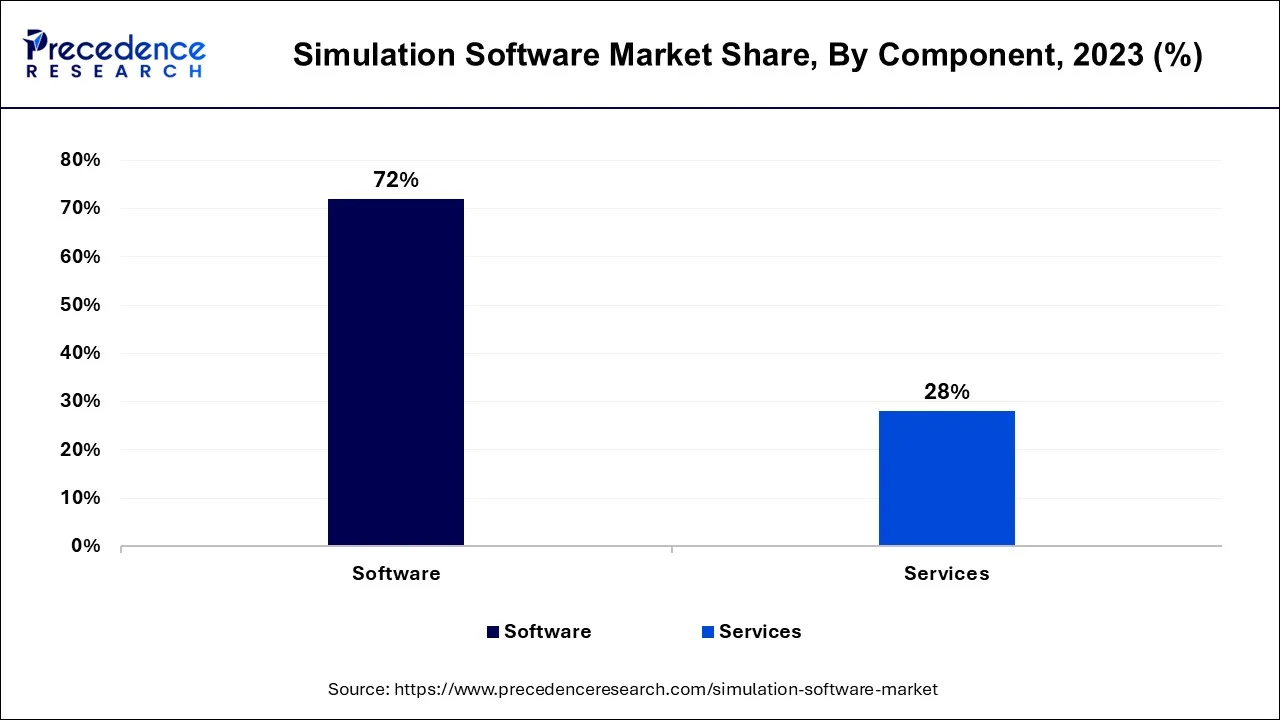
However, throughout the projected period, the service segment is anticipated to increase at the quickest rate. The segment's expansion can be ascribed to governments and businesses being more aware of the virtual procedures employed for product creation. Services like design and consultation, implementation, and maintenance are becoming more and more popular with different businesses. One of the major companies in the industry, ANSYS, Inc., offers expert advice and services for streamlining and compressing the simulation workflow.
In 2023, the market was dominated by the on-premise deployment segment, which accounted for the greatest share of more than 73% of worldwide revenue. The early adoption of the software was cited as the reason for the significant share of this market. The program is installed locally using the on-premise deployment technique, which has been used for a long time. This strategy is excellent for firms who desire to retain the secrecy of their data and secure the data from hackers.
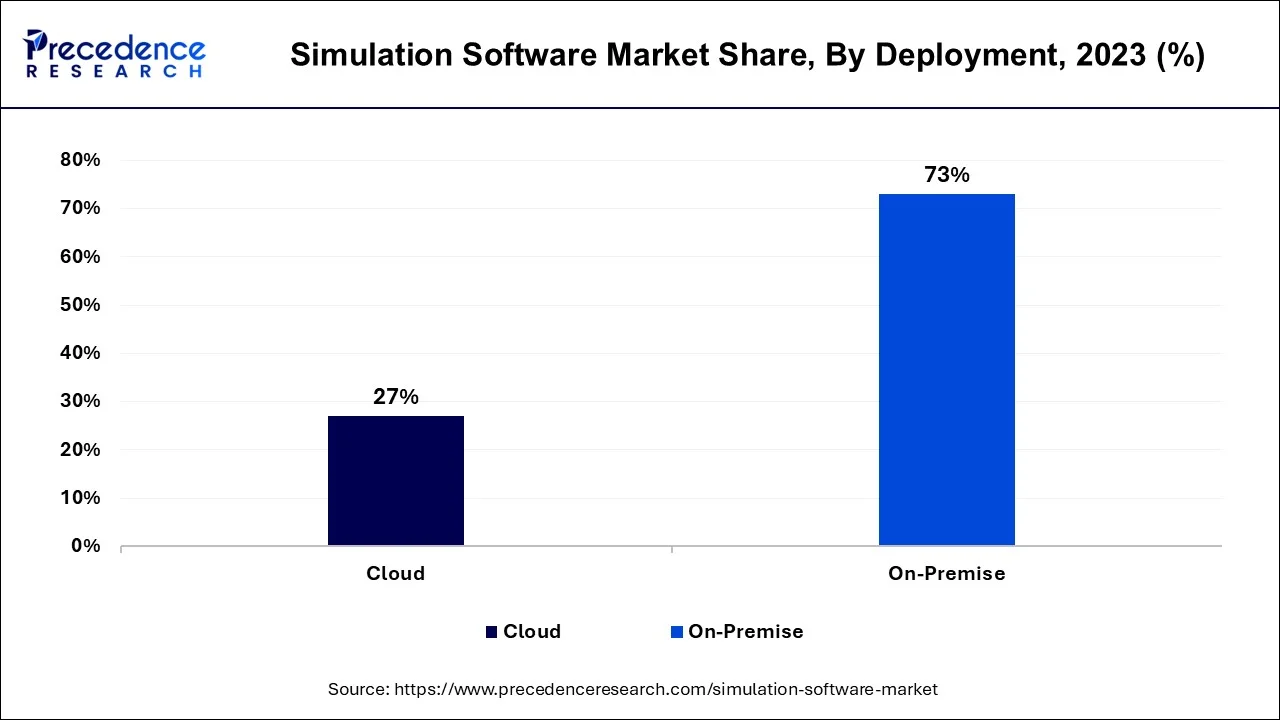
The main elements fostering the segment's expansion are these advantages pertaining to data security and confidentiality. By 2030, the market segment is anticipated to have the largest share. Over the next seven years, the fastest CAGR is anticipated for the cloud category. The advantages provided, including as simple setup and cost effectiveness as compared to conventional on-premise software, can be credited with the segment's rise. The software is simpler to maintain and upgrade based on customer needs because it is distributed via the cloud. Additionally, cloud-based software may be applied to projects like research and development and training and education.
With a market share of almost 37% in 2023, the engineering, research, modeling, and simulated testing sector led the industry. The large segment share is ascribed to the widespread usage of simulation software for product engineering, modeling, research, and testing by well-known end-use organizations like Airbus, Boeing, Volkswagen Group, and others. The need from customers for quick and cost-effective quality improvement is another factor driving the segment's rise. This enables businesses to launch new goods quickly and reduce warranty costs.
Additionally, the shift from physical prototyping to simulation is pervasive across many industries, and the massive investments in high-growth applications like clinical trials, autonomous, 5G, electrification, and the Industrial Internet of Things have increased the demand for modeling, designing, and simulated testing tools (IIoT). Furthermore, various businesses, like the military & defense, business, and others, have always been concerned about cyber dangers. Organizations now have access to cyber situational awareness thanks to the emergence of simulation technologies. Users may more easily spot harmful cyberattacks within that network because to this. Because of this, it is anticipated that there will be widespread adoption of cyber simulation tools, which will aid the segment's growth at a notable CAGR from 2022 to 2030.
According to end-uses, the automotive sector dominated the market in 2023 and contributed more than 28% of total revenue. Early usage of virtual technologies for product development was credited with the increase. The usage of electric and autonomous cars is also changing within the automotive sector. The expansion of this market segment is largely being driven by the use of simulation to improve manufacturing processes in this industry.
Construction, retail, and telecommunications are just a few of the industries and sectors that are included in the other segment. Due to the usage of simulators in the design of both defense and aerospace equipment, the aerospace & defense segment is anticipated to expand at a sizable CAGR during the projected period. Simulators are also employed in the defense sector for army training. Government spending on new and improved defense equipment, which uses simulation software, has surged as a result of growing national security and anti-terrorism concerns. This has therefore helped this market sector to expand.
By Component
By Deployment
By Application
By End Use
By Geography
For inquiries regarding discounts, bulk purchases, or customization requests, please contact us at sales@precedenceresearch.com
No cookie-cutter, only authentic analysis – take the 1st step to become a Precedence Research client
November 2024
January 2025
January 2025
October 2024